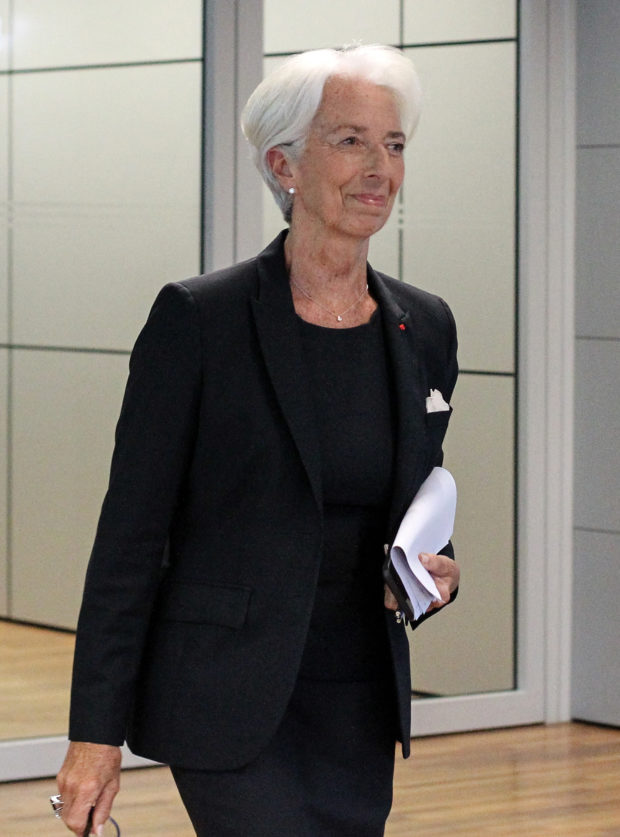
Christine Lagarde, President of the European Central Bank (ECB) arrives for a news conference on eurozone monetary policy following the meeting of the governing council of the ECB in Frankfurt am Main, western Germany, on July 21, 2022. (Photo by Daniel ROLAND / AFP)
The European Central Bank on Thursday brought an end to the era of negative interest rates in the eurozone with a bigger than expected half-point hike to combat soaring inflation, as President Christine Lagarde warned of a darkening economic outlook.
The Frankfurt-based institution dumped its previous guidance that it would raise rates by a more modest 25 basis points and said it was moving to making decisions “meeting-by-meeting”.
The more aggressive move, the ECB’s first rate hike since 2011, reflected an updated “assessment of inflation risks”, the ECB said.
Surging energy costs as a consequence of the Russian invasion of Ukraine saw consumer prices in the eurozone rise at an 8.6 percent-pace in June, an all-time high for the currency club and well above the ECB’s target of two percent.
Since they were announced in June, the ECB’s plans to raise rates have unleashed new stresses on bond markets, with the relative borrowing costs faced by more highly indebted countries rising quickly.
The central bank’s response Thursday was to reveal a new crisis-fighting instrument, dubbed the “Transmission Protection Instrument (TPI)”.
The targeted bond-buying scheme would be used to “counter unwarranted, disorderly market dynamics” that scrambles the ECB’s policy goals, it said.
‘Historic’
With prices taking off, the euro weak against the dollar and other central banks racing ahead with bigger hikes, the ECB was under pressure to act decisively.
Thursday’s hike lifts its deposit facility, the the rate paid by banks to park their cash at the ECB overnight, up to zero percent and out of negative territory for the first time in eight years.
The ECB’s other key interest rates rose in lock-step, also climbing by a half-point.
The “historic” decision reflected anxiety on the governing council that the window
opportunity to raise interest rates could be closing, said Carsten Brzeski, head of macro at the ING bank.
Future rate hikes “will be appropriate”, the ECB said, as it looks to catch up with the US Federal Reserve and the Bank of England which both started raising rates earlier and more aggressively.
The risk that the eurozone will pitch into recession later this year may lead to chances for more hikes being “washed away”, Brzeski said.
“Instead of a long rate hike journey, the ECB’s policy normalization currently rather looks like a short trip,” he said.
“Russia’s unjustified aggression towards Ukraine is an ongoing drag on growth” while driving inflation that would remain “undesirably high for some time”, ECB chief Lagarde told reporters in a press conference.
Europe’s dependence on Russian energy imports has eurozone members bracing for a difficult winter and planning to ration supplies if Moscow halts gas deliveries.
Together, those factors were “significantly clouding the outlook for the second half of 2022,” she said.
‘Going big’
The ECB would “not hesitate” to use its new TPI crisis-fighting tool if the borrowing costs faced by governments in the eurozone begin to show an “unwarranted” divergence, Lagarde said.
The central bank was capable of “going big” to ensure the even transmission of its monetary policy throughout the euro area, she said.
But political turmoil in Rome cast a shadow over the announcement, with the resignation of Italian Prime Minister Mario Draghi on Thursday sending shivers through government debt markets.
Lagarde pointedly declined to comment specifically on the crisis in Italy, instead stressing that the tool was designed to “address a specific risk that all euro area countries can face”.
While the TPI came with economic conditions, the deployment of the tool was also down to the “discretion and judgement” of the ECB’s governing council, Lagarde said.
It may prove difficult to convince the broader public that the ECB is not drawn into political considerations when faced with the crucial decision to activate the TPI,” said Frederik Ducrozet, head of macroeconomic research at Pictet.

